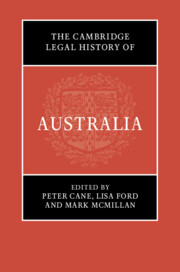Book contents
- The Cambridge Legal History of Australia
- The Cambridge Legal History of Australia
- Copyright page
- Contents
- Figures
- Maps
- Contributors
- Maps
- 1 Editors’ Introduction
- I Cultures of Law
- II Public Authority
- III Public Authorities in Encounter
- IV Land and Environment
- 13 Settlement and Dispossession
- 14 Australian Land Law
- 15 Aboriginal Land Rights, Subjection and the Law
- 16 Land Justice
- 17 Environment
- V Social Organisation
- VI Social Ordering
- VII Reckonings
- Index
15 - Aboriginal Land Rights, Subjection and the Law
from IV - Land and Environment
Published online by Cambridge University Press: 04 August 2022
- The Cambridge Legal History of Australia
- The Cambridge Legal History of Australia
- Copyright page
- Contents
- Figures
- Maps
- Contributors
- Maps
- 1 Editors’ Introduction
- I Cultures of Law
- II Public Authority
- III Public Authorities in Encounter
- IV Land and Environment
- 13 Settlement and Dispossession
- 14 Australian Land Law
- 15 Aboriginal Land Rights, Subjection and the Law
- 16 Land Justice
- 17 Environment
- V Social Organisation
- VI Social Ordering
- VII Reckonings
- Index
Summary
Born of a critical moment in Australia’s social and political history, the Aboriginal Land Rights (Northern Territory) Act 1976 is a vestige of earlier attempts to grapple with Aboriginal rights and restitution. The Act has led to the restitution of large stretches of land and coastal areas in the Northern Territory and has a history of implementation in a relatively consistent policy setting. For many Aboriginal groups, the era of seeking rights under the ALRA has transformed into one of self-management of Country and the seeking of economic and cultural futures for younger generations of Aboriginal landowners. For the first group to lodge a claim under the Act in 1976, the Yanyuwa (and including Binbingka, Garrwa and Mara claimants) in the southwest Gulf of Carpentaria, their story now stretches over four decades. This chapter accounts for existing Indigenous Laws in relation to lands and waters in the Gulf of Carpentaria, norther Australia. These Laws co-exist with white Australian law and have found themselves entangled in the context of an Aboriginal Land Claim. Yanyuwa culture and Law have not been obliterated by legislative land rights nor the legal fight it entails. In fact, many aspects of Law and culture have been assured through the act of generational knowledge transfer that is demanded as an evidentiary mandate, and due to the intense scrutiny of knowledge that must be displayed during the process of land claim hearings.
- Type
- Chapter
- Information
- The Cambridge Legal History of Australia , pp. 354 - 376Publisher: Cambridge University PressPrint publication year: 2022
- 2
- Cited by

